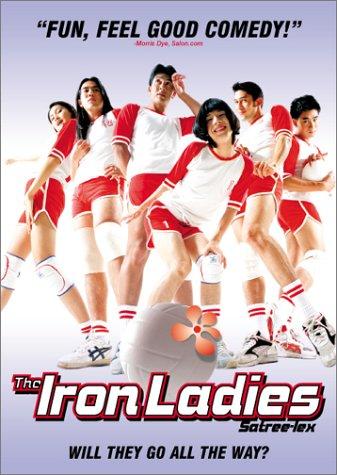|
“The Iron Ladies” was a surprise box office hit in 2000 before a new round of cultural suppression began in 2002. That crack-down was ineffective insofar as its attempt was to curtail public acceptance of gay, kathoey and trans persons into occasional prominence and public acclaim. “The Iron Ladies”, directed by Yongyoot Thongkongthun, is a light-hearted comedy inspired by the nationally-known success, three years earlier, of a volley ball team from the northern city of
Lampang. The team contains a variety of queer players when the previous players dropped out rather than be coached by a woman (a “tom” they claimed [using Thai slang for a lesbian, equivalent to “dyke” as the English subtitles say]). The coach accepts two trans players and so all the boys quit except one who becomes the team captain. Bee, the coach, has to make a team out of them but the obstacles are formidable, including: personality peculiarities, family objections, opposing teams’ ridicule, and then official obstinacy. The team coalesces, wins its way to the national championship and then seems to be blocked by the homophobic, misogynistic tournament organizers, until fans overwhelm them and the main bad guy knocks himself out, so the championship can proceed and be won by the “iron sisters”. As Yongyoot tells the story, key players being recruited and installed into the team have to overcome impediments at home, on the court, and in their own hearts. A closeted gay male player has to come out and openly defy his family to play, while another family is giddy with joy to have their kathoey-trans child going on this adventure. The coach has to confront officials about their rules being made up as they go along – no one dreamed of men playing against a team presenting themselves as an odd form of women. Society, as “The Iron Ladies” portrays it, is coming to terms with gender diversity, but the energy is entirely from the grassroots. The issue is where do these people fit into society and into national culture? Apparently, it will take acts of defiance to make it happen. In retrospect, “The Iron Ladies” is much about defiance. Yongyoot is quite willing to pander to stereotypes. He doesn’t hesitate to have a player come unhinged when she breaks a fingernail. One is reminded of flamboyant Armand in “The Birdcage”. It seems hard to find normal queers in movies of that time (1996). We are all exaggerated. In “The Iron Ladies”, before the final climactic contest, every one of the players and most of their foils has been identified as a type. There is a lack of subtlety about the obedient son, the raging homophobe, the flaming queen, the doting parents, the controlling father, and the pathetic misogynist. There is a satisfying predictability about how those who rise defiantly achieve success and those who do not wither in defeat. The volleyball teams that the ladies face seem incapable of respecting their opponents or accepting defeat gracefully. The fans, in particular, are defiant. Yongyoot clearly signals that sexual minorities have fights to wage. The main impact “The Iron Ladies” makes is not through its blunt messages. Film critic Roger Ebert disagreed with almost everything about the film except the characterization of Bee, the coach. He felt the film was about forty years out of date in its representation of gender diversity and especially its ludicrous stereotyping. Still, the film was the second highest grossing Thai film at the time, a record it held for more than a decade. It spawned two sequels (which were not as good, although profitable by Thai standards). What Ebert could not know when he wrote his review, is that “The Iron Ladies” was to be barrier-breaking in Thailand and East Asia. It was a movie that showed gender diversity positively, showed public acceptance of it, disparaged official repudiation of it, and then even as the credits rolled said “these LGTK people can live happy productive lives after their volleyball victory, in life among you.” No government publication, to this day, makes those claims. Moreover, the movie and its success helped fulfill those assertions. It is a help to be a national champion or a phenomenal success if one is to gain public acceptance. But the bar is lowered as more and more of the public get acquainted with the new normal. The big story of “The Iron Ladies” is about the public perception and positive response. It began with the crowds at the tournament, but spread through the Kingdom of Thailand. These queers had fans from Chiang Rai (far north) to Trang (far south) and that had never happened before. Arnika Fuhrmann of Cornell University puts it this way, “[the film’s] greater emphasis lies on engendering national discourses of advocacy regarding homosexuality and transidentitarian positions.” She concludes, however, that films like “The Iron Ladies” are superficial in that their “potential for radical figurations of queerness remains limited.”
0 Comments
Leave a Reply. |
AuthorRev. Dr. Kenneth Dobson posts his weekly reflections on this blog. Archives
March 2024
Categories |
| Ken Dobson's Queer Ruminations from Thailand |
|

 RSS Feed
RSS Feed
